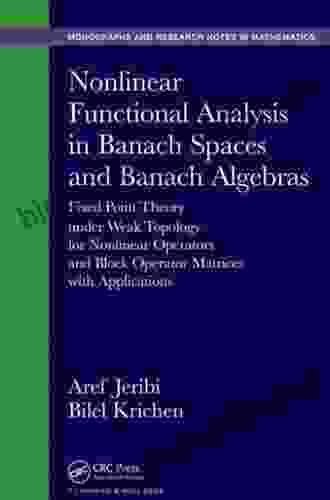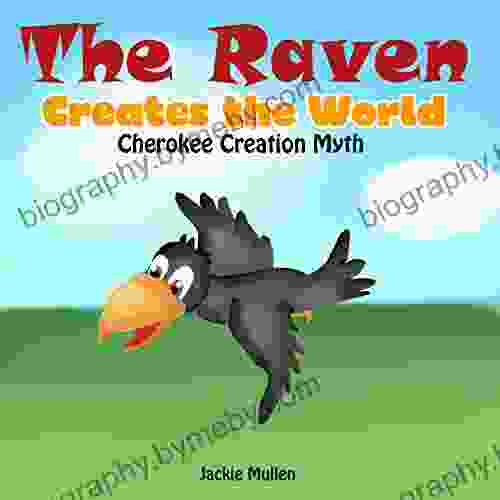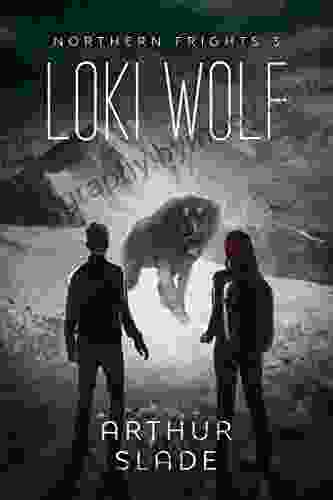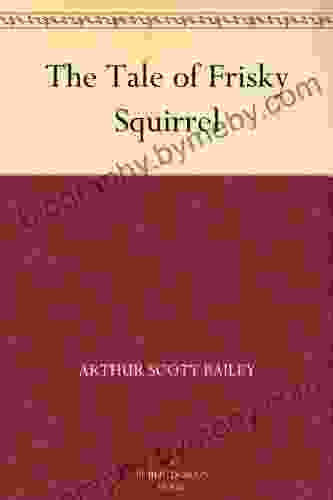Fixed Point Theory Under Weak Topology For Nonlinear Operators And Block

Fixed point theory, a branch of mathematical analysis, delves into the study of mappings that possess fixed points, i.e., points that remain unchanged under the mapping's application. This theory finds widespread applications in diverse fields ranging from pure mathematics to applied sciences.
4.5 out of 5
| Language | : | English |
| File size | : | 12153 KB |
| Screen Reader | : | Supported |
| Print length | : | 371 pages |
Weak topology, on the other hand, offers a generalized framework for studying topological spaces. It extends the classical notion of topology by allowing for weaker convergence criteria, thus capturing a broader range of mathematical structures.
The intersection of these two concepts gives rise to the realm of fixed point theory under weak topology. This specialized area of research explores the existence, uniqueness, and properties of fixed points for nonlinear operators defined on spaces endowed with weak topologies.
Nonlinear Operators and Fixed Points
Nonlinear operators, unlike their linear counterparts, exhibit a more complex and intricate behavior. They often arise in real-world applications, modeling phenomena such as fluid dynamics, population growth, and economic systems.
Fixed points of nonlinear operators play a pivotal role in understanding the long-term behavior of the systems they represent. Finding fixed points allows researchers to determine equilibrium states, stability conditions, and potential bifurcation points.
Weak Topology and its Significance
Weak topology provides a powerful tool for extending fixed point theory to a wider class of spaces. By relaxing the convergence criteria, weak topology enables the analysis of mappings defined on spaces that may not possess the classical topological properties.
This generalization opens up new avenues of exploration, allowing researchers to study fixed points in settings where traditional methods may fall short.
Applications in Mathematical Analysis and Beyond
Fixed point theory under weak topology finds applications in various branches of mathematical analysis, including:
- Functional analysis: studying operators on Banach and Hilbert spaces
- Operator theory: investigating properties of linear and nonlinear operators
- Differential equations: analyzing solutions to ordinary and partial differential equations
Beyond mathematical analysis, this theory also plays a role in:
- Mathematical physics: modeling physical systems with nonlinear dynamics
- Computer science: developing algorithms for solving nonlinear optimization problems
- Economics: analyzing market equilibria and game theory models
Challenges and Future Directions
Despite its rich history and numerous applications, fixed point theory under weak topology continues to present challenges and opportunities for research.
One challenge lies in extending the theory to more general settings, such as non-metric spaces and spaces with variable topologies. Another area of active research involves developing more efficient and robust algorithms for finding fixed points.
The future of fixed point theory under weak topology holds immense promise for advancing our understanding of complex systems and solving real-world problems. By pushing the boundaries of this mathematical discipline, researchers can unlock new insights and contribute to the progress of science and technology.
Fixed point theory under weak topology is a powerful and versatile tool for analyzing nonlinear operators and their fixed points. Its applications span a wide range of disciplines, from pure mathematics to applied sciences.
Understanding the intricacies of this theory empowers researchers and practitioners to tackle complex problems, model real-world phenomena, and uncover hidden patterns in data. As research continues to push the boundaries of fixed point theory, we can expect even more transformative discoveries and groundbreaking applications in the years to come.
4.5 out of 5
| Language | : | English |
| File size | : | 12153 KB |
| Screen Reader | : | Supported |
| Print length | : | 371 pages |
Do you want to contribute by writing guest posts on this blog?
Please contact us and send us a resume of previous articles that you have written.
 Book
Book Novel
Novel Page
Page Chapter
Chapter Text
Text Story
Story Genre
Genre Reader
Reader Library
Library Paperback
Paperback E-book
E-book Magazine
Magazine Newspaper
Newspaper Paragraph
Paragraph Sentence
Sentence Bookmark
Bookmark Shelf
Shelf Glossary
Glossary Bibliography
Bibliography Foreword
Foreword Preface
Preface Synopsis
Synopsis Annotation
Annotation Footnote
Footnote Manuscript
Manuscript Scroll
Scroll Codex
Codex Tome
Tome Bestseller
Bestseller Classics
Classics Library card
Library card Narrative
Narrative Biography
Biography Autobiography
Autobiography Memoir
Memoir Reference
Reference Encyclopedia
Encyclopedia Annabel Chase
Annabel Chase Annette Marie
Annette Marie The Editors Of New York Magazine
The Editors Of New York Magazine Will Hodgkinson
Will Hodgkinson Norman E Bowie
Norman E Bowie Ernestine Hayes
Ernestine Hayes Arlene Cogen
Arlene Cogen Anthony Tommasini
Anthony Tommasini Anne Lamott
Anne Lamott Yunte Huang
Yunte Huang Annie Martin
Annie Martin L M Montgomery
L M Montgomery Rob Ives
Rob Ives Lynn Baber
Lynn Baber Ann Ingalls
Ann Ingalls Anne Mendelson
Anne Mendelson Arthur Atchabahian
Arthur Atchabahian Anthony M Zignego
Anthony M Zignego Anna V Ostenso Moore
Anna V Ostenso Moore Edward Leo
Edward Leo
Light bulbAdvertise smarter! Our strategic ad space ensures maximum exposure. Reserve your spot today!
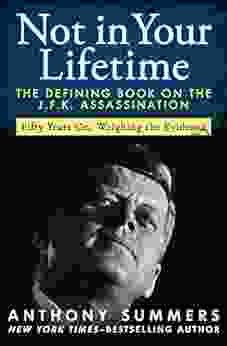
 Samuel Taylor ColeridgeThe Defining Moment: An In-Depth Look at the Assassination of President John...
Samuel Taylor ColeridgeThe Defining Moment: An In-Depth Look at the Assassination of President John...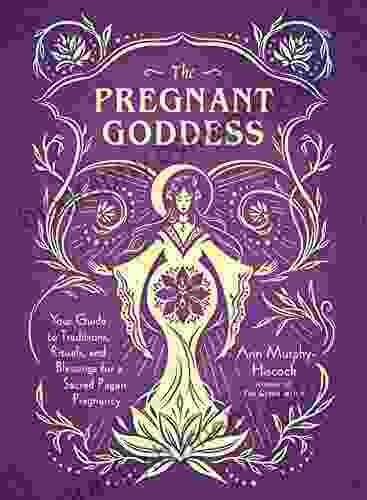
 Carter HayesUnveiling the Sacred Tapestry of Pagan Pregnancy: Your Guide to Traditions,...
Carter HayesUnveiling the Sacred Tapestry of Pagan Pregnancy: Your Guide to Traditions,... Kendall WardFollow ·13.8k
Kendall WardFollow ·13.8k Stan WardFollow ·8.4k
Stan WardFollow ·8.4k Bret MitchellFollow ·16.5k
Bret MitchellFollow ·16.5k Ian PowellFollow ·8.5k
Ian PowellFollow ·8.5k Dave SimmonsFollow ·2.2k
Dave SimmonsFollow ·2.2k Bill GrantFollow ·10.3k
Bill GrantFollow ·10.3k Matt ReedFollow ·5k
Matt ReedFollow ·5k Robbie CarterFollow ·10.1k
Robbie CarterFollow ·10.1k

 Juan Rulfo
Juan RulfoThe Easy Ingredient Ketogenic Diet Cookbook: Your...
Embark on a culinary adventure that...
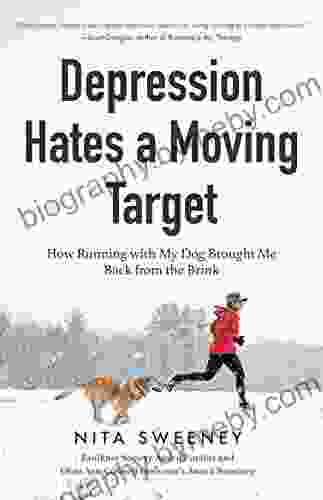
 Zachary Cox
Zachary CoxDepression Hates a Moving Target: A Groundbreaking...
Depression...

 Colin Richardson
Colin RichardsonUnleash Your Spine-Tingling Curiosity: Dive into the...
In the realm of...

 Evan Hayes
Evan HayesMarketing Fashion Portfolio: The Ultimate Guide to...
In the competitive world of fashion, it is...
4.5 out of 5
| Language | : | English |
| File size | : | 12153 KB |
| Screen Reader | : | Supported |
| Print length | : | 371 pages |


